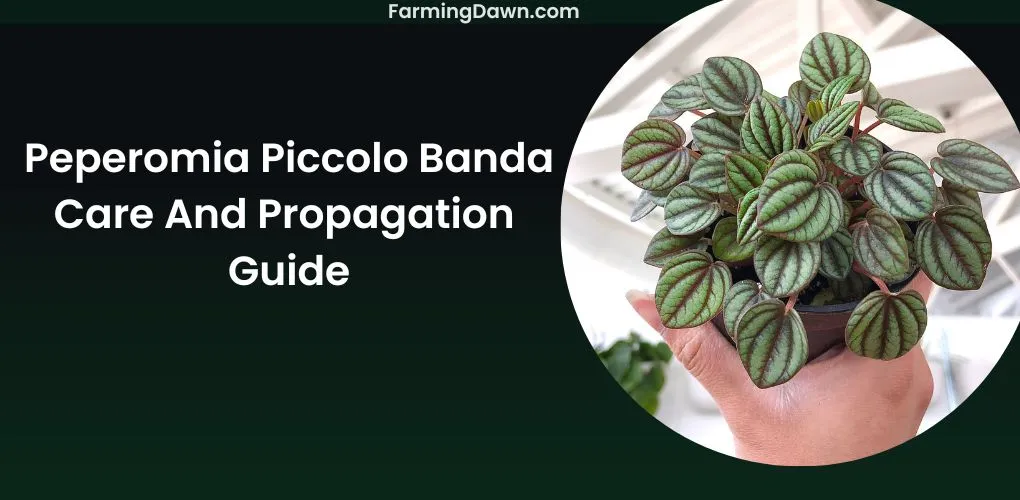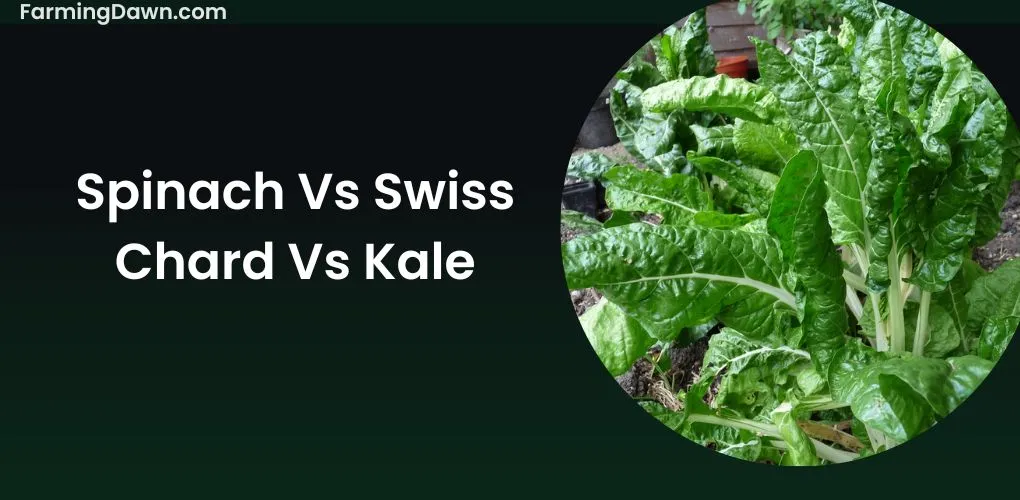Peperomia piccolo banda is one of the most unique and interesting plants in the Peperomia genus. It has stunning, vibrant foliage that stands out among other houseplants and looks beautiful in any home decor. As a horticulturist specializing in this species, I’d love to share my extensive knowledge with you so that you can get the most out of your piccolo banda!
In this article, we’ll be exploring the overview, care needs, growth habits, planting tips, potential problems, and propagation techniques for peperomia piccolo banda. With these helpful tips in hand, you’ll feel more confident about giving your plant the best possible environment and watching it thrive over time, allowing it to become an integral part of your home’s atmosphere as well as bringing warmth and joy into your life!
Overview Of Peperomia Piccolo Banda
Peperomia piccolo banda is an evergreen, perennial succulent native to South America. It’s a low-growing plant with dark green leaves and contrasting white stripes that make it perfect for adding a pop of color to any room. This particular variety has small pointed leaves and gorgeous red stems which add to its beauty.
While this peperomia generally doesn’t suffer from many pest problems, occasionally mealybugs may become an issue but can easily be taken care of with regular inspections of the foliage. The unique coloring of this beautiful plant makes it an excellent accent piece in any indoor environment, providing both style and substance!
Related: Hoya retusa care and propagation guide.
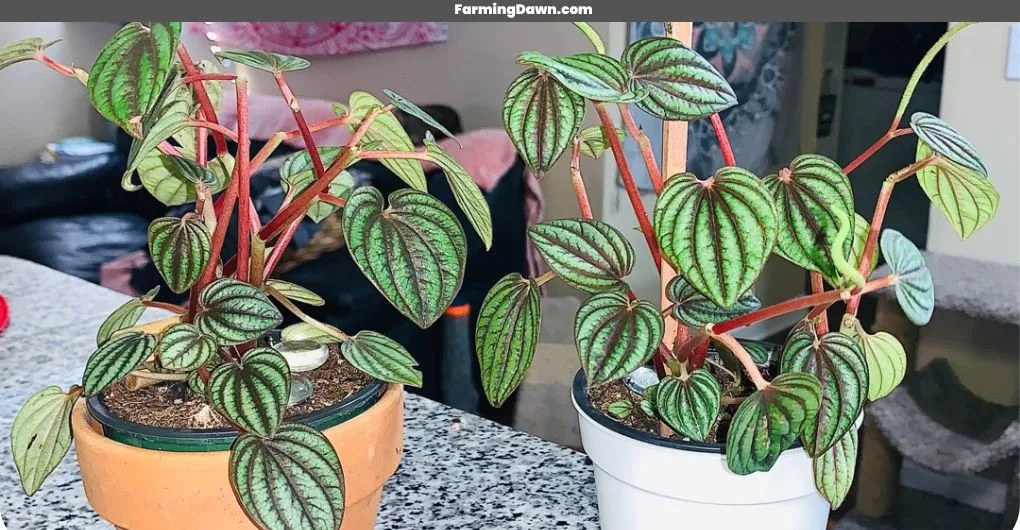
Here take a quick overview of this beautiful plant!
| Common Name | Peacock plant, Radiator plant |
| Scientific Name | Peperomia Albovittata ‘Piccolo Banda’ |
| Family | Piperaceae family and Peperomia genus |
| Origin | Rainforests of South America |
| Appearance | thick, silvery-green leaves with numerous bands of heavy, dark-green, occasionally purple-tinged veining running down their length. |
| Size | height and width of 6-12 inches |
| Soil | rich, well-drained soil that is slightly acidic to neutral |
| Water | During the growing season, water them once every week or every two weeks, and lessen water in the winter. |
| Temperature | 60-85F |
| Sunlight | bright but indirect sunlight |
| Toxicity | Non-toxic to pets and people |
| USDA zone | 10-11 |
| Common issues | Pests (mealybugs, spider mites, whitefly) and diseases (leaf spot and root rot) |
How Do You Care For A Peperomia Piccolo Banda?
When it comes to caring for peperomia piccolo, the irony is that this plant loves a good challenge. It thrives in moderate light and requires frequent watering (about once every week or two) to keep its soil moist but not soggy. Peperomia piccolo banda enjoys high humidity levels as well, so misting your plant occasionally will help it grow healthy and strong.
See more: How to care for Pilea depressa plant?
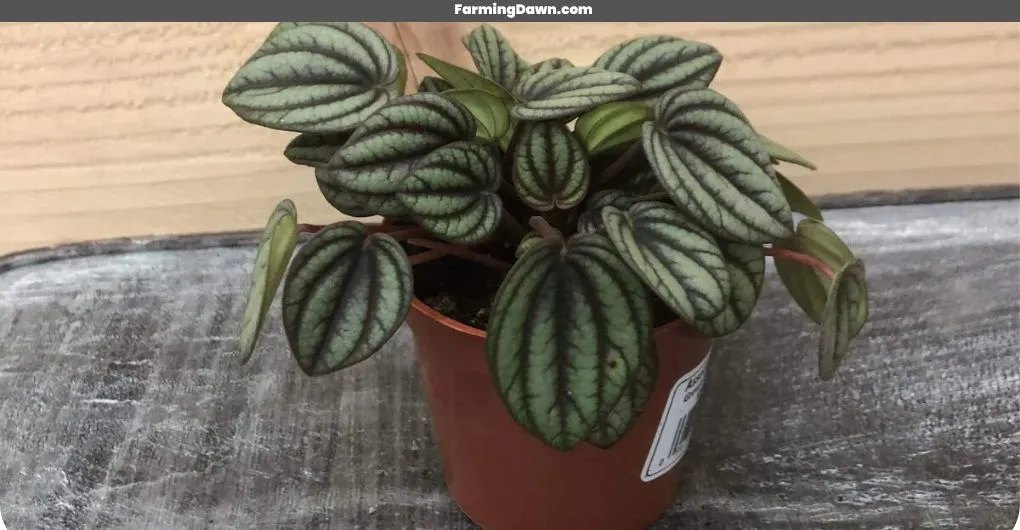
Let’s discuss the points that play major roles in the successful growth of this species.
Soil Requirements
When it comes to soil requirements, the best-growing medium will be one that is well-draining and contains organic matter. The number of nutrients in the soil should be moderate; too many can cause root burn while not enough can lead to deficiencies. Loam or a combination of loam and perlite makes an ideal substrate as they provide good drainage but also retain moisture and aeration which are essential for healthy growth.
Watering Tips
Piccolo banda’s watering needs are quite similar to that of other succulents, with less water than more traditional plants like ferns and philodendrons. Allow the soil to dry out completely between waterings, as too much moisture can cause root rot.
Water using tepid/room temperature water when possible as this helps prevent shock from cold tap water. Also, be sure not to overwater your plant! The nickname “watermelon” given to peperomia banda hints at the amount of hydration they need, just enough so they won’t shrivel up but don’t drown them either.
Fertilization Guidelines
The best time for fertilizing peperomia piccolo banda is during the springtime when it starts actively growing. In order to maximize growth potential, use an all-purpose liquid fertilizer that can be diluted in water according to package instructions. Avoid using too much fertilizer since this could result in burning or stressing out your plant.
Fertilize regularly throughout the season but reduce the frequency as temperatures start to cool down in late summer/early fall before dormancy sets in. If done correctly, proper fertilization of piccolo banda should lead to healthier plants and increased propagation success!
Learn more: How do you care for Homalomena Selby?
Light Requirements
Peperomia piccolo banda has moderate light requirements and prefers bright indirect sunlight. To keep the plant healthy, it should be placed in an area away from direct sunlight or harsh artificial lighting. This will also help to bring out its vibrant colors of soft whites and greens.
The peperomia flower is known for its delicate white blooms with a hint of pink, making it stand out among other houseplants. Also, if you give your peperomia enough light, you’ll be rewarded with these beautiful flowers throughout the year! With the right care, this tropical species can bring life into any home or office space.
Pruning And Maintenance
With its striking resemblance to miniature watermelons, this radiator plant is easy on the eyes and can jazz up any living space. It’s also quite low maintenance, requiring only occasional pruning of dead or yellowing leaves and regular watering once per week.
Cats in particular love this plant due to its fuzzy foliage; if you’re a cat owner, consider adding peperomia piccolo banda! When properly cared for, it provides vibrant greens that are sure to draw attention and plenty of affection from your furry friends. So don’t hesitate to give this species a try today!
Temperature Considerations
While peperomia piccolo banda may seem like a low-maintenance delight, there are still some temperature considerations one needs to keep in mind when caring for these plants. In order to thrive, they require temperatures between 65-85 degrees Fahrenheit during the day, and should not drop below 60 degrees at night.
Too much variation from these recommendations can cause your precious little friend distress and even stunt their growth. Be sure to provide them with optimal temperatures so you can enjoy watching them flourish!
See more: See the complete care guide on Philodendron Quercifolium.
Containers And Potting
Having the right container to house your piccolo banda is essential for its health and well-being. Generally, a medium-sized pot with good drainage is ideal as it can provide enough space for growth but still be easy to move around when necessary. It’s best to use a shallow terracotta or plastic pot for watermelon peperomia plants; both materials will help keep the soil moist yet allow excess water to drain away from the root system.
Also, make sure the pot has one or two holes at the bottom so that any extra moisture can escape without becoming soggy. For optimal results, fill the bottom of the pot with gravel before adding in your choice of soil mix, this method helps ensure proper aeration and drainage which are key factors for keeping your plant healthy!
Common Problems
Peperomia is a delightful houseplant to own, but it can be prone to certain problems that might not affect other plants. These problems are:
- Overwatering
While this plant prefers slightly moist soil, too much water will cause root rot and ultimately kill the plant.
- Frequent shallow watering
It’s especially important to avoid frequent shallow watering, as this encourages fungal growth and root damage. Furthermore, you should remember that peperomia piccolo banda does better in dry air than many of its succulent cousins like watermelon peperomia.
If the humidity level gets too high for too long, your plant may start to suffer from leaf yellowing or wilting. To ensure success with your piccolo banda, keep an eye on both moisture levels and air quality, and proper care means healthy plants!
How To Propagate Peperomia Piccolo Banda?
When it comes to propagating piccolo banda, cutting and layering are two of the most popular techniques. Cutting involves taking stem cuttings from existing plants and rooting them in soil, while layering involves burying a stem in soil and rooting it there.
Both methods are easy to use, and provide great results when done correctly. If you carry out the steps carefully, these techniques can help you grow healthy and vibrant peperomia piccolo banda plants.
Related: How to propagate Hoya Linearis?
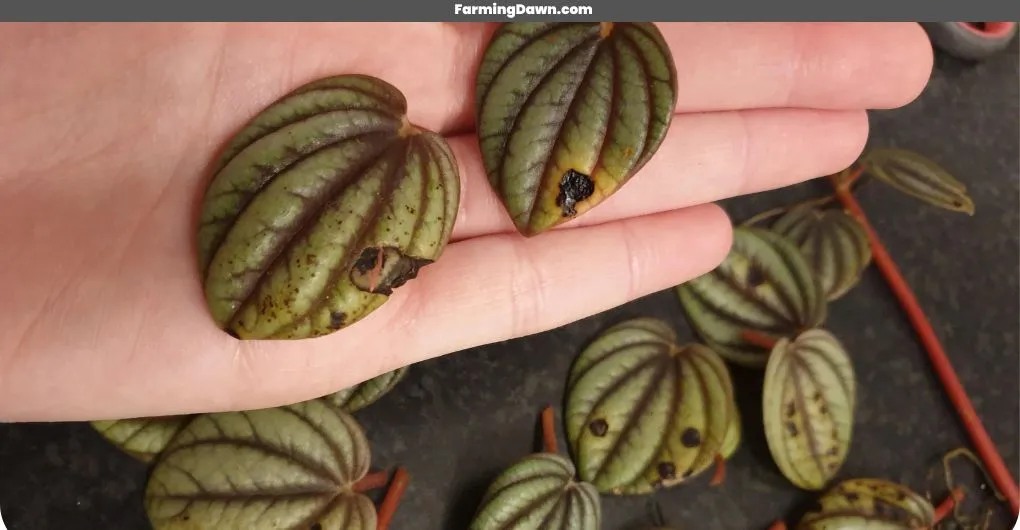
Cutting
Stem cutting works best when the plant is actively growing in spring and summer as this gives you more material to work with. When cutting your stems, always use clean scissors or shears and make sure that each cutting contains at least one node (from which new roots will form).
The remaining length of the cutting should be between 3-5 inches long, any shorter and it may struggle to develop properly, while longer cuttings can become unruly. Place your cuttings in a container filled with moist soil mix, then water them regularly until they have established themselves before transferring them into individual pots. With some patience, you’ll soon see new growth emerging!
Layering
Layering is another propagation technique that can be used with the Peperomia plant, and it’s a great way to increase the number of plants you have. To layer this plant, simply choose a healthy stem, bend it down gently until it touches the soil, then secure it there using stakes or clips.
You’ll need to keep the area around your layered cutting moist so that new roots form, try misting them regularly or placing a plastic bag over the top of the cuttings for extra humidity. Once enough roots are established (usually within 2-3 weeks) you can sever them from the main plant and transfer them into their own pot! This method will allow you to grow more beautiful peperomias in no time at all.
Uses And Benefits Of Peperomia Piccolo Banda
Piccolo banda is not only a beautiful and vibrant addition to any home, but it can also bring many benefits. This plant has been popular for its ability to reduce indoor air pollution, as well as adding moisture to the air. One of its greatest uses is its ability to brighten up dark corners in your home with its colorful foliage and variegated leaves.
Not only that, but peperomia piccolo banda requires very little maintenance making it perfect for busy households or those who don’t want to spend too much time tending their plants. Its low-maintenance nature makes it ideal for keeping indoors throughout the year without fear of disease or pests destroying it, which means you get all the beauty with none of the efforts!
Frequently Asked Questions Related To Peperomia Piccolo Banda
How do you water Peperomia Piccolo?
Water Peperomia Piccolo thoroughly when the top 1-2 inches of soil feel dry to the touch, but avoid overwatering or letting the plant sit in standing water. It prefers bright, indirect light and well-draining soil.
How big do Peperomia Piccolo Banda get?
Piccolo Banda is a small plant that typically grows up to 6 inches (15 cm) in height and spread. It’s compact size and slow growth rate make it a perfect choice for small spaces or as a desktop plant.
Is Peperomia Piccolo Banda toxic to dogs?
According to the American Society for the Prevention of Cruelty to Animals (ASPCA), Peperomia plant is non-toxic to dogs and other pets. However, it is always best to keep plants out of reach of curious pets to prevent accidental ingestion.
Where does Peperomia Piccolo Banda come from?
Piccolo Banda is a cultivar of the Peperomia family that was developed through selective breeding. Its exact origin is unknown, but Peperomia species are native to tropical and subtropical regions of Central and South America, as well as parts of Africa.
Peperomia Piccolo Banda Care: Final Thoughts
The Piccolo Banda is truly a remarkable plant. Its vibrant foliage, ease of care, and propagation make it ideal for any home or office setting. With minimal effort, you can have an attractive houseplant that will bring life to your space for years to come.
I highly recommend this tropical species to anyone looking for a beautiful and low-maintenance addition to their living environment. I’ve personally enjoyed my own plants over many months – from watching them grow and change color with each season, to admiring their unique shapes and textures. There’s nothing quite like having this stunning species as part of my indoor garden!

